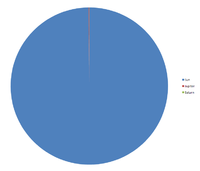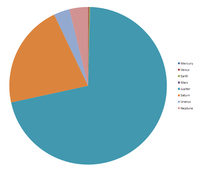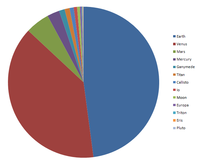List of Solar System objects by size: Difference between revisions
| [pending revision] | [pending revision] |
→Selected objects between 200 and 100 km in radius: fixed ordering |
Per the Non-free content criteria #10c, all non-free files on this page must have a specific non-free use rationale. |
||
| Line 78: | Line 78: | ||
| [[Star]] |
| [[Star]] |
||
|regular |
|regular |
||
|-style="background:#ddd;" |
|-style="background:#ddd;" |
||
|[[Jupiter]] |
|[[Jupiter]] |
||
|bgcolor=black|[[File:Jupiter by Cassini-Huygens.jpg|50px]] |
|bgcolor=black|[[File:Jupiter by Cassini-Huygens.jpg|50px]] |
||
| Line 314: | Line 314: | ||
|[[Pluto]]<sup>R</sup><br><small> 134340</small> |
|[[Pluto]]<sup>R</sup><br><small> 134340</small> |
||
|bgcolor=black|[[File:Pluto-map-hs-2010-06-c180.jpg|50px]] <!-- HST / NASA --> |
|bgcolor=black|[[File:Pluto-map-hs-2010-06-c180.jpg|50px]] <!-- HST / NASA --> |
||
|1,161<ref name=young07>{{cite journal|bibcode=2007DPS....39.6205Y |title=Pluto's Radius|author=Young, Eliot F.; Young, L. A.; Buie, M. |journal=American Astronomical Society, DPS meeting #39, #62.05; Bulletin of the American Astronomical Society|volume=39|page=541|year=2007}}</ref>< |
|1,161<ref name=young07>{{cite journal|bibcode=2007DPS....39.6205Y |title=Pluto's Radius|author=Young, Eliot F.; Young, L. A.; Buie, M. |journal=American Astronomical Society, DPS meeting #39, #62.05; Bulletin of the American Astronomical Society|volume=39|page=541|year=2007}}</ref><br />(w/o gas) |
||
|0.181 |
|0.181 |
||
|7.15 |
|7.15 |
||
| Line 420: | Line 420: | ||
|600–800<ref name=Sedna-LKBO> |
|600–800<ref name=Sedna-LKBO> |
||
{{cite book |
{{cite book |
||
| chapter = The largest Kuiper belt objects |
|||
| title = The Solar System Beyond Neptune |
|||
| pages = 335–345 |
|||
| editor = M. Antonietta Barucci, Hermann Boehnhardt, Dale P. Cruikshank |
|||
| author = Michael E. Brown |
|||
| publisher = University of Arizona Press |
|||
| isbn = 0-8165-2755-5 |
|||
| url = http://www.gps.caltech.edu/~mbrown/papers/ps/kbochap.pdf |
|||
| format = pdf |
|||
}} |
}} |
||
</ref> |
</ref> |
||
| Line 445: | Line 445: | ||
|bgcolor=black|[[File:1880-CT MBrown SPOTLIGHT medium.jpg|30px]] |
|bgcolor=black|[[File:1880-CT MBrown SPOTLIGHT medium.jpg|30px]] |
||
|≈600<ref name="Brown2011">{{cite web |
|≈600<ref name="Brown2011">{{cite web |
||
|year=2011 |
|||
|title=The Surface Composition of Large Kuiper Belt Object 2007 OR10 |
|||
|publisher=Mike Brown's Website |
|||
|author=[[Michael E. Brown]]; Burgasser, A.J.; Fraser W.C. |
|||
|url=http://www.gps.caltech.edu/~mbrown/papers/ps/or10.pdf |
|||
|arxiv=1108.1418 |
|||
|accessdate=2011-08-08}}</ref>–710<ref name=Brown>Mike Brown, ''How many dwarf planets are there in the outer solar system?''[http://www.gps.caltech.edu/~mbrown/dps.html]</ref> |
|||
|0.094 |
|0.094 |
||
|0.904 |
|0.904 |
||
| Line 478: | Line 478: | ||
|-style="background:#CCFFCC;" |
|-style="background:#CCFFCC;" |
||
|[[Ariel (moon)|Ariel]] <sup>‡</sup> <br><small> Uranus I</small> |
|[[Ariel (moon)|Ariel]] <sup>‡</sup> <br><small> Uranus I</small> |
||
|bgcolor=black|[[File:Ariel-NASA.jpg|50px]] |
|bgcolor=black|[[File:Ariel-NASA.jpg|50px]] |
||
|578.9 |
|578.9 |
||
|0.091 |
|0.091 |
||
| Line 544: | Line 544: | ||
|- |
|- |
||
|[[Ceres (dwarf planet)|Ceres]]<sup>‡</sup> <br><small> 1</small> |
|[[Ceres (dwarf planet)|Ceres]]<sup>‡</sup> <br><small> 1</small> |
||
|bgcolor=black|[[File: |
|bgcolor=black|[[File:Ceres optimized.jpg|50px]] |
||
|475 |
|475 |
||
|0.076 |
|0.076 |
||
| Line 560: | Line 560: | ||
|bgcolor=black|[[File:Quaoar PRC2002-17e.jpg|50px]] |
|bgcolor=black|[[File:Quaoar PRC2002-17e.jpg|50px]] |
||
|445<ref name=Brown2010>{{cite journal |
|445<ref name=Brown2010>{{cite journal |
||
|last=Brown |first=Michael E. |
|||
|coauthors=Fraser, Wesley C. |
|||
|title=Quaoar: A Rock in the Kuiper belt |
|||
|journal=The Astrophysical Journal |
|||
|volume= 714|issue= 2|pages= 1547|year=2010 |
|||
|arxiv=1003.5911 |
|||
|bibcode = 2010ApJ...714.1547F |
|||
|doi=10.1088/0004-637X/714/2/1547 |
|||
}}</ref> |
}}</ref> |
||
| 0.07 |
| 0.07 |
||
| Line 816: | Line 816: | ||
|colspan="8"| |
|colspan="8"| |
||
|[[Detached object]]<ref name=Buie10KZ39>{{cite web |
|[[Detached object]]<ref name=Buie10KZ39>{{cite web |
||
|author=[[Marc W. Buie]] |
|||
|date=2010-06-16 using 19 of 19 observations over 0.98 years (356 days) |
|||
|title=Orbit Fit and Astrometric record for 10KZ39 |
|||
|publisher=SwRI (Space Science Department) |
|||
|url=http://www.boulder.swri.edu/~buie/kbo/astrom/10KZ39.html |
|||
|accessdate=2011-08-18}}</ref> or [[Classical Kuiper belt object|Cubewano]]<ref name=MPC10KZ39>{{cite web |
|||
|title=2010 KZ39 |
|||
|publisher=IAU Minor Planet Center |
|||
|url=http://www.minorplanetcenter.net/db_search/show_object?object_id=2010+KZ39&commit=Show |
|||
|accessdate=2011-08-18}}</ref> |
|||
|unknown |
|unknown |
||
|- |
|- |
||
| Line 986: | Line 986: | ||
! class="unsortable" | Volume<br><small>(V<sub>⊕</sub>)</small> |
! class="unsortable" | Volume<br><small>(V<sub>⊕</sub>)</small> |
||
! Mass<br><small>{{e|21}} kg <br> ([[Yottagram|Yg]]) </small> |
! Mass<br><small>{{e|21}} kg <br> ([[Yottagram|Yg]]) </small> |
||
! class="unsortable" | |
! class="unsortable" | Mass<br><small>(M<sub>⊕</sub>)</small> |
||
! Density<ref>Densities of those KBOs whose masses are uncertain are assumed to be 2.0 in line with Pluto</ref><br><small>g/cm<sup>3</sup></small> |
! Density<ref>Densities of those KBOs whose masses are uncertain are assumed to be 2.0 in line with Pluto</ref><br><small>g/cm<sup>3</sup></small> |
||
! Surface gravity <br> (m/s<sup>2</sup>) |
! Surface gravity <br> (m/s<sup>2</sup>) |
||
| Line 1,047: | Line 1,047: | ||
|unknown |
|unknown |
||
|- |
|- |
||
|{{mpl|2004 XR|190}} <br><small> |
|{{mpl|2004 XR|190}} <br><small> "Buffy"</small> |
||
|bgcolor=black| |
|bgcolor=black| |
||
|277<ref name="johnston2010">{{cite web |
|277<ref name="johnston2010">{{cite web |
||
| Line 1,096: | Line 1,096: | ||
|- |
|- |
||
|[[2 Pallas|Pallas]]<sup>$</sup> <br><small> 2</small> |
|[[2 Pallas|Pallas]]<sup>$</sup> <br><small> 2</small> |
||
|bgcolor=black|[[File:PallasHST2007.jpg|50px|]] |
|bgcolor=black|[[File:PallasHST2007.jpg|50px| ]] |
||
|266<ref>{{cite web|author=Alan Chamberlin |url=http://ssd.jpl.nasa.gov/sbdb.cgi?sstr=2;orb=0;cov=0;log=0;cad=0#phys_par |title=JPL Small-Body Database Browser |publisher=Ssd.jpl.nasa.gov |date= |accessdate=2011-01-04|archiveurl = http://www.webcitation.org/5wRXdqRMp |archivedate = 2011-02-12|deadurl=no}}</ref> |
|266<ref>{{cite web|author=Alan Chamberlin |url=http://ssd.jpl.nasa.gov/sbdb.cgi?sstr=2;orb=0;cov=0;log=0;cad=0#phys_par |title=JPL Small-Body Database Browser |publisher=Ssd.jpl.nasa.gov |date= |accessdate=2011-01-04|archiveurl = http://www.webcitation.org/5wRXdqRMp |archivedate = 2011-02-12|deadurl=no}}</ref> |
||
|0.042 |
|0.042 |
||
| Line 1,482: | Line 1,482: | ||
|[[(145480) 2005 TB190|(145480) 2005 TB<sub>190</sub>]] |
|[[(145480) 2005 TB190|(145480) 2005 TB<sub>190</sub>]] |
||
|bgcolor=black| |
|bgcolor=black| |
||
|186.25 <!-- Muller2010 (335-410 diameter) --><ref name=autogenerated2>{{cite journal|last=Muller|first=T.G.|coauthors=Lellouch, E.; Stansberry, |
|186.25 <!-- Muller2010 (335-410 diameter) --><ref name=autogenerated2>{{cite journal|last=Muller|first=T.G.|coauthors=Lellouch, E.; Stansberry, J. ''et al.''|title="TNOs are Cool": A survey of the trans-Neptunian region I. Results from the Herschel science demonstration phase (SDP)|journal=Astronomy and Astrophysics|volume=518|year=2010|page=L146|doi=10.1051/0004-6361/201014683|bibcode=2010A&A...518L.146M|url=http://adsabs.harvard.edu/abs/2010A%26A...518L.146M|archiveurl = http://www.webcitation.org/5wRXdDjxM |archivedate = 2011-02-12|deadurl=no}}</ref> |
||
| <!-- |0.039 |
| <!-- |0.039 |
||
|0.065 |
|0.065 |
||
| Line 1,490: | Line 1,490: | ||
|2.0 |
|2.0 |
||
|{{Gr|0.13|250}} |
|{{Gr|0.13|250}} |
||
|0.014 |
|0.014 for 250 km radius --> |
||
|[[Detached object]] |
|[[Detached object]] |
||
|unknown |
|unknown |
||
| Line 1,588: | Line 1,588: | ||
|bgcolor=black|[[File:TX300-2009Nov16-04UT.jpg|50px]] |
|bgcolor=black|[[File:TX300-2009Nov16-04UT.jpg|50px]] |
||
|143<!--286/2 = 143--><ref name="msnbc55636">{{cite web |
|143<!--286/2 = 143--><ref name="msnbc55636">{{cite web |
||
|date=2010-06-16 |
|||
|title=Scientists size up a bright mini-world |
|||
|publisher=MSNBC |
|||
|author=Clara Moskowitz |
|||
|url=http://www.msnbc.msn.com/id/37735465/ns/technology_and_science-space/ |
|||
|accessdate=2010-06-16}}</ref> |
|||
|12 <!-- assumed value from wiki page--> |
|12 <!-- assumed value from wiki page--> |
||
|[[Kuiper belt object]]—[[Haumea family]] |
|[[Kuiper belt object]]—[[Haumea family]] |
||
| Line 1,647: | Line 1,647: | ||
|title=JPL Small-Body Database Browser: 65 Cybele |
|title=JPL Small-Body Database Browser: 65 Cybele |
||
|url=http://ssd.jpl.nasa.gov/sbdb.cgi?sstr=65 |
|url=http://ssd.jpl.nasa.gov/sbdb.cgi?sstr=65 |
||
|accessdate=2008-11-25| archiveurl = http://www.webcitation.org/5mqpk4wfX |archivedate = 2010-01-17| deadurl=no}}</ref> |
|accessdate=2008-11-25| archiveurl = http://www.webcitation.org/5mqpk4wfX |archivedate = 2010-01-17| deadurl=no}}</ref> <small>IRAS</small> |
||
|17.8 |
|17.8 |
||
|Outer [[main-belt asteroid]]{{mdash}}[[C-type asteroid|C-type]] |
|Outer [[main-belt asteroid]]{{mdash}}[[C-type asteroid|C-type]] |
||
| Line 1,820: | Line 1,820: | ||
|url=http://web.media.mit.edu/~win/hstpub.pdf |
|url=http://web.media.mit.edu/~win/hstpub.pdf |
||
|accessdate=2005-01-15 |
|accessdate=2005-01-15 |
||
|doi=10.1006/icar.1999.6047 |bibcode=1999Icar..137..260S}} {{Dead link|date=October 2010|bot=H3llBot}}</ref> |
|doi=10.1006/icar.1999.6047 |bibcode=1999Icar..137..260S}} {{Dead link|date=October 2010|bot=H3llBot}}</ref> <!-- old 103.9--> |
||
|12.7 |
|12.7 |
||
|[[Main-belt asteroid]]{{mdash}}[[G-type asteroid|G-type]] |
|[[Main-belt asteroid]]{{mdash}}[[G-type asteroid|G-type]] |
||
| Line 1,950: | Line 1,950: | ||
===Selected objects between 100 and 50 km in radius=== |
===Selected objects between 100 and 50 km in radius=== |
||
Objects 100 and 50 km in radius (200 km to 100 km in average diameter). This currently includes most objects in the [[asteroid belt]] and moons of the [[gas giants]] in this size range, but is missing many newly discovered objects in the outer Solar System such |
Objects 100 and 50 km in radius (200 km to 100 km in average diameter). This currently includes most objects in the [[asteroid belt]] and moons of the [[gas giants]] in this size range, but is missing many newly discovered objects in the outer Solar System such as here.<ref name="johnstonsarchive1"/> [[Asteroid spectral types]] are mostly Tholen, but some might be SMASS. |
||
{| class="wikitable sortable" |
{| class="wikitable sortable" |
||
| Line 1,970: | Line 1,970: | ||
|[[Main-belt asteroid]]{{mdash}}[[S-type asteroid|S-type]] |
|[[Main-belt asteroid]]{{mdash}}[[S-type asteroid|S-type]] |
||
|- |
|- |
||
| [[24 Themis]] |
| [[24 Themis]] <sup>M</sup> |
||
|bgcolor=black| |
|bgcolor=black| |
||
|99 |
|99 |
||
| Line 2,024: | Line 2,024: | ||
|[[Main-belt asteroid]]{{mdash}}[[M-type asteroid|M-type]] |
|[[Main-belt asteroid]]{{mdash}}[[M-type asteroid|M-type]] |
||
|- |
|- |
||
|[[6 Hebe]] |
|[[6 Hebe]] <sup>$</sup> |
||
|bgcolor=black| |
|bgcolor=black| |
||
|92.59<ref name=PSI/> <!-- old: 93.1--> |
|92.59<ref name=PSI/> <!-- old: 93.1--> |
||
| Line 2,134: | Line 2,134: | ||
|issue=1 |
|issue=1 |
||
|page=286 |
|page=286 |
||
|bibcode=2007Icar..191..286G}}</ref> <!-- old data |
|bibcode=2007Icar..191..286G}}</ref> <!-- old data 229.7 / 2 = 114.85 <ref name=spitzer/> --> |
||
|5.4<ref name="Grundy2007"/> |
|5.4<ref name="Grundy2007"/> |
||
|[[Centaur (minor planet)|Centaur]]{{mdash}}[[Trans-Neptunian object|TNO]]{{mdash}}[[Minor planet moon|binary]] |
|[[Centaur (minor planet)|Centaur]]{{mdash}}[[Trans-Neptunian object|TNO]]{{mdash}}[[Minor planet moon|binary]] |
||
| Line 4,403: | Line 4,403: | ||
| [[2000 Herschel]] |
| [[2000 Herschel]] |
||
|bgcolor=black| |
|bgcolor=black| |
||
| 8<ref>[http://asteroidoccultation.com/2011_08/0826_2000_24820_Summary.txt |
| 8<ref>[http://asteroidoccultation.com/2011_08/0826_2000_24820_Summary.txt IOTA/IOTA-ES occultation update for (2000) Herschel]</ref> |
||
| |
| |
||
|[[Main-belt asteroid]]<ref>[http://ssd.jpl.nasa.gov/sbdb.cgi?ID=a0002000 JPL Small-Body Database Browser: 2000 Herschel]</ref> |
|[[Main-belt asteroid]]<ref>[http://ssd.jpl.nasa.gov/sbdb.cgi?ID=a0002000 JPL Small-Body Database Browser: 2000 Herschel]</ref> |
||
| Line 4,488: | Line 4,488: | ||
|bgcolor=black| |
|bgcolor=black| |
||
|5.0<ref name=sheppard>{{cite web |
|5.0<ref name=sheppard>{{cite web |
||
|title=Uranus' Known Satellites |
|||
|publisher=Carnegie Institution (Department of Terrestrial Magnetism) |
|||
|author=[[Scott S. Sheppard]] |
|||
|url=http://www.dtm.ciw.edu/users/sheppard/satellites/urasatdata.html |
|||
|accessdate=2011-01-22}}</ref> |
|||
| |
| |
||
|[[Moons of Uranus|Satellite of Uranus]] |
|[[Moons of Uranus|Satellite of Uranus]] |
||
| Line 4,695: | Line 4,695: | ||
|- |
|- |
||
|[[2867 Šteins]] |
|[[2867 Šteins]] |
||
|bgcolor=black| |
|bgcolor=black| |
||
|2.65<!--5.3 km mean diameter--><ref name="keller">[http://www.sciencemag.org/cgi/content/abstract/327/5962/190http://www.sciencemag.org/cgi/content/abstract/327/5962/190 H. U. Keller, et all - '''E-Type Asteroid (2867) Steins as Imaged by OSIRIS on Board Rosetta''' - Science 8 January 2010: Vol. 327. no. 5962, pp. 190 - 193 DOI: 10.1126/science.1179559] {{dead link|date=February 2011}}</ref> |
|2.65<!--5.3 km mean diameter--><ref name="keller">[http://www.sciencemag.org/cgi/content/abstract/327/5962/190http://www.sciencemag.org/cgi/content/abstract/327/5962/190 H. U. Keller, et all - '''E-Type Asteroid (2867) Steins as Imaged by OSIRIS on Board Rosetta''' - Science 8 January 2010: Vol. 327. no. 5962, pp. 190 - 193 DOI: 10.1126/science.1179559] {{dead link|date=February 2011}}</ref> |
||
| |
| |
||
| Line 5,030: | Line 5,030: | ||
|≈800<ref>[http://www.spaceref.com/news/viewpr.html?pid=23753 Minor Planet No. 100,000 Named for Space Age 50th Anniversary (2007) - Space Ref, Quote: "..about a mile in size"]</ref> |
|≈800<ref>[http://www.spaceref.com/news/viewpr.html?pid=23753 Minor Planet No. 100,000 Named for Space Age 50th Anniversary (2007) - Space Ref, Quote: "..about a mile in size"]</ref> |
||
| |
| |
||
|Inner Main-belt Asteroid<ref>[JPL Small-Body Database Browser: 100000 Astronautica]</ref> |
|Inner Main-belt Asteroid<ref>[JPL Small-Body Database Browser: 100000 Astronautica]</ref> |
||
|- |
|- |
||
|[[Dactyl (moon)|Dactyl]]<br><sup>Ida I</sup> |
|[[Dactyl (moon)|Dactyl]]<br><sup>Ida I</sup> |
||
| Line 5,128: | Line 5,128: | ||
|- |
|- |
||
|[[6489 Golevka]] |
|[[6489 Golevka]] |
||
|bgcolor=black| |
|bgcolor=black| <!-- radar to CGI --> |
||
|350<ref>{{cite web|author=Alan Chamberlin |url=http://ssd.jpl.nasa.gov/sbdb.cgi#top |title=JPL Small-Body Database Browser |publisher=Ssd.jpl.nasa.gov |date= |accessdate=2011-01-04|archiveurl = http://www.webcitation.org/5wRY4Rkg7 |archivedate = 2011-02-12|deadurl=no}}</ref> |
|350<ref>{{cite web|author=Alan Chamberlin |url=http://ssd.jpl.nasa.gov/sbdb.cgi#top |title=JPL Small-Body Database Browser |publisher=Ssd.jpl.nasa.gov |date= |accessdate=2011-01-04|archiveurl = http://www.webcitation.org/5wRY4Rkg7 |archivedate = 2011-02-12|deadurl=no}}</ref> |
||
| |
| |
||
| Line 5,134: | Line 5,134: | ||
|- |
|- |
||
|[[25143 Itokawa]] |
|[[25143 Itokawa]] |
||
|bgcolor=black| |
|bgcolor=black| |
||
| 346 |
| 346 |
||
|0.0358 |
|0.0358 |
||
| Line 5,163: | Line 5,163: | ||
|[[Near-Earth asteroid]]{{mdash}}[[Apollo asteroid|Apollo]] |
|[[Near-Earth asteroid]]{{mdash}}[[Apollo asteroid|Apollo]] |
||
|- |
|- |
||
|[[2005 YU55]] |
|[[2005 YU55]] <ref>[http://www.bbc.co.uk/news/science-environment-15572634 BBC - '''Giant asteroid passes near Earth''' - 9 November 2011]</ref> |
||
|bgcolor=black|[[File:2005YU55-20111107.jpg|50px|center]] |
|bgcolor=black|[[File:2005YU55-20111107.jpg|50px|center]] |
||
|155-170<ref>[http://www.mpg.de/4652308/2005_YU55_rocks_in_space?filter_order=L The Herschel Space Observatory catches a glimpse of the minor planet during its rendezvous with Earth (November 17, 2011)]</ref> |
|155-170<ref>[http://www.mpg.de/4652308/2005_YU55_rocks_in_space?filter_order=L The Herschel Space Observatory catches a glimpse of the minor planet during its rendezvous with Earth (November 17, 2011)]</ref> |
||
| |
| |
||
| Line 5,276: | Line 5,276: | ||
| [[File:Callisto.jpg|center|100x100px]] |
| [[File:Callisto.jpg|center|100x100px]] |
||
| [[File:Io highest resolution true color.jpg|center|100x100px]] |
| [[File:Io highest resolution true color.jpg|center|100x100px]] |
||
| [[File:Cara-oculta-luna.jpg|center|100x100px]] |
| [[File:Cara-oculta-luna.jpg|center|100x100px]] |
||
|- |
|- |
||
| '''[[Mars]]''' |
| '''[[Mars]]''' |
||
| Line 5,289: | Line 5,289: | ||
| [[File:Triton moon mosaic Voyager 2 (large).jpg|center|100x100px]] |
| [[File:Triton moon mosaic Voyager 2 (large).jpg|center|100x100px]] |
||
| [[File:Titania (moon) color cropped.jpg|center|110x110px]] |
| [[File:Titania (moon) color cropped.jpg|center|110x110px]] |
||
| [[File:PIA08148 (Rhea-Splat).jpg|center|100x100px]] |
| [[File:PIA08148 (Rhea-Splat).jpg|center|100x100px]] |
||
| [[File:Voyager 2 picture of Oberon.jpg|center|100x100px]] |
| [[File:Voyager 2 picture of Oberon.jpg|center|100x100px]] |
||
| [[File:Iapetus as seen by the Cassini probe - 20071008.jpg|center|100x100px]] |
| [[File:Iapetus as seen by the Cassini probe - 20071008.jpg|center|100x100px]] |
||
| Line 5,303: | Line 5,303: | ||
|-style="background: Black;" |
|-style="background: Black;" |
||
| [[File:Ariel-NASA.jpg|center|100x100px]] |
| [[File:Ariel-NASA.jpg|center|100x100px]] |
||
| [[File:Dionean Linea PIA08256.jpg|center|100x100px]] |
| [[File:Dionean Linea PIA08256.jpg|center|100x100px]] |
||
| [[File:Inset-sat tethys-large.jpg|center|100x100px]] |
| [[File:Inset-sat tethys-large.jpg|center|100x100px]] |
||
| [[File:Vesta from Dawn, July 17.jpg|center|100x100px]] |
| [[File:Vesta from Dawn, July 17.jpg|center|100x100px]] |
||
| [[File:Enceladus from Voyager.jpg|center|100x100px]] |
| [[File:Enceladus from Voyager.jpg|center|100x100px]] |
||
| [[File:Miranda.jpg|center|100x100px]] |
| [[File:Miranda.jpg|center|100x100px]] |
||
| Line 5,318: | Line 5,318: | ||
| '''[[Proteus (moon)|Proteus]]''' |
| '''[[Proteus (moon)|Proteus]]''' |
||
|-style="background: Black;" |
|-style="background: Black;" |
||
| [[File:Mimas before limb sharp (colored).jpg|center|100x100px]] |
| [[File:Mimas before limb sharp (colored).jpg|center|100x100px]] |
||
| [[File:Hyperion in natural colours.jpg|center|100x100px]] |
| [[File:Hyperion in natural colours.jpg|center|100x100px]] |
||
| [[File:Phoebe cassini.jpg|center|100x100px]] |
| [[File:Phoebe cassini.jpg|center|100x100px]] |
||
Revision as of 02:20, 25 December 2011
Template:Lists of Solar System objects

This is a list of Solar System objects by size, arranged in descending order of mean volumetric radius. The list can also be partially sorted according to an object's mass and, for the largest objects, volume, density and surface gravity. This list contains the Sun, the planets, (candidate) dwarf planets, many of the larger small Solar System bodies (which includes the asteroids), all named natural satellites, and a number of smaller objects of historical or scientific interest, such as comets and near-Earth objects.
The ordering may be different depending on whether one chooses radius or mass, because some objects are denser than others. For instance Uranus is bigger than Neptune but less massive, and although Ganymede and Titan are larger than Mercury, they have less than half its mass. This means some objects in the lower tables, despite their smaller radii, may be more massive than objects in the upper tables because they have a higher density.
Many trans-Neptunian objects (TNOs) have been discovered, and their approximate locations in this list are shown, even though there can be a large uncertainty in their measurement.
Solar System objects more massive than 1021 kilograms (one yottagram [Yg]) are known or expected to be approximately spherical. Astronomical bodies relax into rounded shapes (ellipsoids), achieving hydrostatic equilibrium, when the gravity of their mass is sufficient to overcome the structural strength of their material. These are dubbed "regular". Objects made of ice become regular more easily than those made of rock, and many icy objects are spheroidal at far lower sizes. The cutoff boundary for regularity is somewhere between 100 km and 200 km in radius.[1]
The larger objects in the mass range between 1018 kg to 1021 kg (1 to 1000 zettagrams (Zg)) such as Tethys, Ceres, and Mimas, have relaxed to an equilibrium oblate spheroid due to their gravity, while the less massive rubble piles (e.g. Amalthea and Janus) are roughly rounded, but not spherical, dubbed "irregular".
Spheroidal bodies typically have some polar flattening due to the centrifugal force from their rotation, but a characteristic feature of the "irregular"-shaped bodies is that there is a significant difference in the length of their two equatorial diameters.
There can be difficulty in figuring out the diameter (within a factor of about 2) for typical objects beyond Saturn. (See 2060 Chiron as an example.) For TNOs there is some confidence in the diameters, but for non-binary TNOs there is no real confidence in the "unreferenced wiki-assumed" masses/densities. Many TNOs are just assumed to have a density of 2.0 g/cm3, though it is just as likely that they have a comet-like density of only 0.5 g/cm3.[2] Thus most provisional TNOs are not given an MEarth value to prevent from cluttering the list with too many assumptions that could be off by an order of magnitude. For example, if a TNO is poorly assumed to have a mass of 3.59×1020 kg based on a radius of 350 km with a density of 2 g/cm3 and is later discovered to only have a radius of 175 km with a density of 1 g/cm3, the mass estimate would be only 2.24×1019 kg.
The sizes and masses of many of the moons of Jupiter and Saturn are fairly well known due to numerous observations and interactions of the Galileo and Cassini orbiters. But many of the moons with a radius less than ~100 km, such as Jupiter's Himalia, still have unknown masses with assumed densities.[3] Again, as we get further from the Sun than Saturn, things get less clear. There has not yet been an orbiter around Uranus or Neptune for long-term study of the moons. For the small outer irregular moons of Uranus, such as Sycorax, which were not discovered by the Voyager 2 flyby, even different NASA web pages, such as the National Space Science Data Center[4] and JPL Solar System Dynamics,[3] have somewhat contradictory size and albedo estimates depending on which research paper is being cited.
Data for objects has varying reliability including uncertainties in the figures for mass and radius, and irregularities in the shape and density, with accuracy often depending on how close it is to Earth or if it has been visited by a probe.
-
The relative masses of the bodies of the Solar System. Objects smaller than Saturn are not visible at this scale.
-
The relative masses of the Solar planets. Jupiter at 71% of the total and Saturn at 21% dominate the system. Mercury and Mars, which together are less than 0.1%, are not visible at this scale.
-
The relative masses of the solid bodies of the Solar System. Earth at 48% and Venus at 39% dominate. Bodies less massive than Pluto are not visible at this scale.
List
Objects above ≈300 km in radius
Anything above this size is probably in hydrostatic equilibrium, but some bodies near the end of this list may not. However, their predicted or measured size would need to be "grossly in error" or their composition primarily rocky, for them not to be.[5] A lot of the values are manually calculated assuming sphericity. Size may or may not include an object's atmosphere. The diameter of Saturn's rings is around 364,900 km, much wider than Jupiter, but its gaseous sphere is smaller.
| Body | Image | Mean radius (km) |
Mean radius (R⊕) |
Volume (109 km3) |
Volume (V⊕) |
Mass ×1021 kg (Yg) |
Mass (M⊕) |
Density[6] g/cm3 |
Surface gravity (m/s2) |
Surface gravity (⊕) |
Type of object | Shape |
|---|---|---|---|---|---|---|---|---|---|---|---|---|
| Sun | 696,000 | 109.25 | 1,412,000,000 | 1,303,781 | 1,989,100,000 | 332,837 | 1.409 | 274.0 | 28.02 | Star | regular | |
| Jupiter | 69,911 | 10.97 | 1,431,280 | 1,321 | 1,898,600 | 317.83 | 1.33 | 24.79 | 2.535 | Planet (gas giant) | regular | |
| Saturn | 58,232 (w/o rings) |
9.14 | 827,130 | 764 | 568,460 | 95.159 | 0.70 | 10.445 | 1.06 | Planet (gas giant) | regular | |
| Uranus | 
|
25,362 | 3.98 | 68,340 | 63.1 | 86,832 | 14.536 | 1.30 | 8.87 | 0.90 | Planet (gas giant) | regular |
| Neptune | 
|
24,622 | 3.86 | 62,540 | 57.7 | 102,430 | 17.147 | 1.76 | 11.15 | 1.140 | Planet (gas giant) | regular |
| Earth | 
|
6,371.0 | 1 | 1,083.21 | 1 | 5,973.6 | 1 | 5.515 | 9.78033 | 1 | Planet (terrestrial) | regular |
| Venus | 
|
6,051.8 (w/o gas) |
0.950 | 928.43 | 0.857 | 4,868.5 | 0.815 | 5.24 | 8.872 | 0.91 | Planet (terrestrial) | regular |
| Mars | 
|
3,390.0 | 0.532 | 163.18 | 0.151 | 641.85 | 0.107 | 3.94 | 3.7 | 0.38 | Planet (terrestrial) | regular |
| Ganymede† Jupiter III |

|
2,631.2 | 0.413 | 76.30 | 0.0704 | 148.2 | 0.0248 | 1.936 | 1.428 | 0.15 | Satellite of Jupiter | regular |
| Titan† Saturn VI |

|
2,576[7] (w/o gas) |
0.404 | 71.52 | 0.0660 | 134.5 | 0.0225 | 1.88 | 1.354 | 0.14 | Satellite of Saturn | regular |
| Mercury | 
|
2,439.7 | 0.383 | 60.83 | 0.0562 | 330.2 | 0.0553 | 5.43 | 3.7 | 0.38 | Planet (terrestrial) | regular |
| Callisto† Jupiter IV |

|
2,410.3 | 0.378 | 58.65 | 0.0541 | 107.6 | 0.018 | 1.83 | 1.23603 | 0.126 | Satellite of Jupiter | regular |
| Io† Jupiter I |

|
1,821.5 | 0.286 | 25.32 | 0.0234 | 89.3 | 0.015 | 3.528 | 1.797 | 0.183 | Satellite of Jupiter | regular |
| Moon | 
|
1,737.1 | 0.273 | 21.958 | 0.0203 | 73.5 | 0.0123 | 3.3464 | 1.625 | 0.166 | Satellite of Earth | regular |
| Europa† Jupiter II |

|
1,561 | 0.245 | 15.93 | 0.0147 | 48 | 0.00803 | 3.01 | 1.316 | 0.134 | Satellite of Jupiter | regular |
| Triton† Neptune I |

|
1,353.4 | 0.212 | 10.38 | 0.0096 | 21.5 | 0.00359 | 2.061 | 0.782 | 0.0797 | Satellite of Neptune | regular |
| ErisR 136199 |

|
1,163[8] | 0.182 | 7 | 0.007 | 16.7[9] | 0.0027 | 2.25 | 0.659 | 0.0677 | Dwarf planet—SDO—binary | regular |
| PlutoR 134340 |

|
1,161[10] (w/o gas) |
0.181 | 7.15 | 0.0066 | 13.105 | 0.0022 | 2.0 | 0.61 | 0.062 | Dwarf planet— KBO |
regular |
| Titania‡ Uranus III |

|
788.9 | 0.124 | 2.06 | 0.0019 | 3.526 | 0.00059 | 1.72 | 0.378 | 0.0385 | Satellite of Uranus | regular |
| Rhea‡ Saturn V |

|
764.1[11] | 0.12 | 1.87 | 0.0017 | 2.3166 | 0.00039 | 1.23 | 0.26 | 0.027 | Satellite of Saturn | regular |
| Oberon† Uranus IV |

|
761.4 | 0.12 | 1.85 | 0.0017 | 3.014 | 0.0005 | 1.63 | 0.347 | 0.035 | Satellite of Uranus | regular |
| Iapetus† Saturn VIII |

|
735.6[12] | 0.113 | 1.55 | 0.0014 | 1.9739 | 0.00033 | 1.08 | 0.223 | 0.0227 | Satellite of Saturn | regular |
| MakemakeRA 136472 |

|
710[13] | 0.126 –0.157 |
1.8 | 0.002 | 3 | 0.00067 | 2.0 | 0.4 | 0.04 | Dwarf planet— KBO |
regular |
| Charon† Pluto I |
603.5[14] | 0.095 | 0.87 | 0.0008 | 1.52 | 0.00025 | 1.65 | 0.279 | 0.028 | Satellite of Pluto | regular | |
| SednaRA 90377 |

|
600–800[15] | 0.09 –0.14 |
1.73 | 0.0016 | 3 | 0.00050 | 2.0 | 0.33 –0.50 |
0.0337 –0.0511 |
Detached object | unknown |
| 2007 OR10 225088 "Snow White" |
≈600[16]–710[5] | 0.094 | 0.904 | 0.0008 | 1.81P | 0.0003 | 2.0P | 0.168 | 0.017 | SDO | unknown | |
| Umbriel† Uranus II |

|
584.7 | 0.092 | 0.84 | 0.0008 | 1.2 | 0.00020 | 1.4 | 0.234 | 0.024 | Satellite of Uranus | regular |
| Ariel ‡ Uranus I |
File:Ariel-NASA.jpg | 578.9 | 0.091 | 0.81 | 0.0008 | 1.35 | 0.00022 | 1.67 | 0.269 | 0.027 | Satellite of Uranus | regular |
| HaumeaR 136108 |
File:2003 EL61.jpg | 575[17]–750[5] | 0.117 | 1.3–1.6 | 0.001 | 4.006 | 0.00069 | 2.551[18] | 0.44 | 0.045 | Dwarf planet— KBO—trinary |
regular (scalene ellipsoid) |
| Dione† Saturn IV |

|
561.6 | 0.088 | 0.73 | 0.0007 | 1.096 | 0.000183 | 1.48 | 0.232 | 0.0236 | Satellite of Saturn | regular |
| Tethys‡ Saturn III |

|
533 | 0.083 | 0.624 | 0.0006 | 0.6173 | 0.000103 | 1.15 | 0.145 | 0.015 | Satellite of Saturn | regular |
| Ceres‡ 1 |

|
475 | 0.076 | 0.437 | 0.0004 | 0.95 | 0.000159 | 2.08 | 0.27 | 0.0275 | Dwarf planet—Asteroid | regular |
| Quaoar 50000 |
445[19] | 0.07 | 0.37 | 0.0003 | 1.6[19] | 0.0003 | 4.2[19] | 0.125 | 0.013 | KBO—Cubewano—binary | unknown | |
| OrcusRA 90482 |
425[13] | 0.069 –0.08 |
0.4 | 0.0004 | 0.63A | 0.0001 | 1.5 | 0.233 | 0.023 | KBO—Plutino—binary | unknown | |
| 2002 TC302R 84522 |
410–570[20] | 0.09 | 0.786 | 0.0007 | 1.573P | 0.00026 | 2.0 | 0.32 | 0.033 | KBO — 2:5 resonance | unknown | |
| 2007 UK1269 229762 |
File:MinorPlanet-2007uk126-19970930.gif | 375[5] | 0.069 | 0.354 | 0.0003 | 0.708P | 0.0001 | 2.0 | 0.245 | 0.025 | SDO | unknown |
| 2005 UQ5139 202421 |
375[5] | 0.074 | 0.443 | 0.0004 | 0.886P | 0.0001 | 2.0 | 0.277 | 0.0284 | KBO—Cubewano | unknown | |
| 2003 MW129 174567 |
375[5] | 0.0658 | 0.308 | 0.0003 | 0.616P | 0.0001 | 2.0 | 0.228 | 0.02 | KBO | unknown | |
| 2002 AW197R 55565 |
370[5] | 0.0576 | 0.207 | 0.00019 | 0.414P | 0.000069 | 2.0 | 0.205 | 0.0211 | KBO[21] | unknown | |
| 2005 QU1829 303775 |
365[5] | 0.082 | 0.606 | 0.00056 | 1.21P | 0.0002 | 2.0 | 0.293 | 0.03 | SDO[22] | unknown | |
| 2002 MS4 | 360[5]R | 0.057 | 0.203 | 0.00018 | 0.4005P | 0.000067 | 2.0P | 0.203 | 0.02086 | KBO[21] | unknown | |
| 2007 JJ43 278361 |
350[5] | TNO[21] | unknown | |||||||||
| 2003 AZ84R 208996 |
345[5] | 0.0538 | 0.169 | 0.000156 | 0.53P | 5.66 E-5 | 2.0P | 0.171 | 0.02 | KBO—Plutino—binary | unknown | |
| 2010 EK139 | 340[5] | SDO | unknown | |||||||||
| 2002 UX25R 55637 |

|
340[5] | 0.0535 | 0.166 | 0.000153 | 0.331P | 0.0000554 | 2.0 | 0.19 | 0.01952 | KBO—binary | unknown |
| 2004 GV9R 90568 |
340[5] | 0.0531 | 0.162 | 0.00015 | 0.325P | 0.0000534 | 2.0 | 0.189 | 0.0194 | KBO | unknown | |
| 2006 QH1819 | 340[5] | 0.06 | 0.233 | 0.000215 | 0.467P | 0.00008 | 2.0 | 0.214 | 0.022 | SDO | unknown | |
| 2005 RN439 145452 |
330[5] | 0.0573 | 0.2036 | 0.00019 | 0.407P | 0.000068 | 2.0 | 0.204 | 0.02096 | KBO[21] | unknown | |
| 2010 KZ39 | 330[5] | Detached object[23] or Cubewano[24] | unknown | |||||||||
| IxionRA 28978 |
Template:Listrow | KBO | unknown | |||||||||
| 2004 XA192 230965 |
320[5] | 0.055 | 0.177 | 0.00016 | 0.354P | 0.000059 | 2.0 | 0.195 | 0.02 | TNO[21] | unknown | |
| 2003 VS2 84922 |
315[5] | 0.057 | 0.203 | 0.00018 | 0.4005P | 0.000067 | 2.0 | 0.203 | 0.02086 | KBO—Plutino[21] | unknown | |
| 2001 UR1639 42301 |
305[5] | 0.05 | 0.134 | 0.00012 | 0.269P | 0.000045 | 2.0P | 0.178 | 0.018 | SDO[21] | unknown | |
| Salacia 120347 |
305[5] | 0.0455 | 0.102 | 0.00009 | 0.2P | 0.000034 | 2.0P | 0.159 | 0.016 | KBO—binary | unknown | |
| 2010 RE64 | 305[5] | KBO | unknown | |||||||||
| 2010 RF43 | 305[5] | SDO | unknown | |||||||||
| 2004 PF115 175113 |
305[5] | KBO—Plutino | unknown | |||||||||
| 2003 UZ4139 | 300[5] | 0.048 | 0.116 | 0.00012 | 0.33P | 0.000055 | 2.0P | 0.24 | 0.0246 | KBO—Plutino | unknown | |
| 2008 ST291 | 300[5] | SDO | unknown | |||||||||
| 2010 FX86 | 300[5] | KBO—Cubewano | unknown | |||||||||
Selected objects between ≈300 and ≈200 km in radius
Satellites in this size range tend to be round (although Proteus is not), and TNOs are expected to be as well, assuming the estimated size is correct. The asteroid 10 Hygiea is not, and 2 Pallas and 4 Vesta are borderline.
| Body | Image | Mean radius (km) |
Mean radius (R⊕) |
Volume (109 km3) |
Volume (V⊕) |
Mass ×1021 kg (Yg) |
Mass (M⊕) |
Density[25] g/cm3 |
Surface gravity (m/s2) |
Surface gravity (⊕) |
Type of object | Shape |
|---|---|---|---|---|---|---|---|---|---|---|---|---|
| 2005 RM439 145451 |
290[26] | 0.0455 | 0.102 | 0.00009 | 0.2P | 0.000034 | 2.0P | 0.159 | 0.016 | KBO | unknown | |
| 2004 NT33 | 290[21] | 0.043 | 0.089 | 0.000082 | 0.178P | 0.000029 | 2.0P | 0.155 | 0.0158 | KBO—Cubewano[21] | unknown | |
| 1996 TL66RA 15874 |
Template:Listrow[5] | SDO | unknown | |||||||||
| 2004 UX10 144897 |
284.5[5] | 0.039 | 0.065 | 0.00006 | 0.13P | 0.000022 | 2.0P | 0.139 | 0.014 | KBO | unknown | |
| 2004 XR190 "Buffy" |
277[21]* | 0.059 | 0.221 | 0.0002 | 0.4416P | 0.00007 | 2.0P | 0.21 | 0.0215 | SDO[21] | unknown | |
| 2004 TY364* 120348 |
277[21] | 0.043 | 0.089 | 0.000082 | 0.178P | 0.000029 | 2.0P | 0.155 | 0.0158 | KBO[21] | unknown | |
| HuyaR 38628 |
266[20] | 0.04175 | 0.0788 | 0.000073 | 0.158P | 0.00026 | 2.0P | 0.149 | 0.015 | KBO—Plutino | unknown | |
| Pallas$ 2 |
266[27] | 0.042 | 0.078 | 0.00007 | 0.211 | 0.0000353 | 2.8[28] | 0.199 | 0.02 | Asteroid | uncertain | |
| Vesta$ 4 |

|
264.6 | 0.042 | 0.078 | 0.00007 | 0.262 | 0.0000438 | 3.42[29] | 0.25 | 0.0256 | Asteroid | regular? |
| 2004 PR107 | 264.5[21] | 0.0345 | 0.0446 | 0.00004 | 0.089P | 0.000014 | 2.0P | 0.123 | 0.0126 | KBO | unknown | |
| 2003 QX113 | 252.5[21] | 0.036 | 0.051 | 0.00005 | 0.102P | 0.000017 | 2.0P | 0.129 | 0.013 | SDO[21] | unknown | |
| Enceladus‡ Saturn II |

|
252.1 | 0.039 | 0.067 | 0.00006 | 0.108 | 0.0000181 | 1.61 | 0.111 | 0.0113 | Satellite of Saturn | regular |
| Varuna* 20000 |
250[5]–530 | 0.049 | 0.125 | 0.000115 | 0.37 | 6.2E-5 | 0.992[18] | 0.258 | 0.028 | KBO | unknown | |
| 2006 HH123 | 239[5] | 0.031 | 0.0335 | 0.000011 | 0.067P | 0.000011 | 2.0 | 0.112 | 0.011 | Centaur[21] | unknown | |
| Miranda‡ Uranus V |

|
235.8 | 0.037 | 0.055 | 0.00005 | 0.0659 | 0.000011 | 1.20 | 0.0791 | 0.00806 | Satellite of Uranus | regular |
| 1999 DE9 26375 |
230.5[20] | 0.036 | 0.051 | 0.000047 | 0.1026P | 0.000017 | 2.0 | 0.129 | 0.013 | KBO | unknown | |
| Chaos* 19521 |
230–372.5[22] | 0.0585 | 0.216 | 0.0002 | 0.4328P | 0.00007 | 2.0P | 0.208 | 0.021 | KBO—Cubewano | unknown | |
| 1998 SN165* 35671 |
230[26] | 0.036 | 0.05 | 0.000046 | 0.1P | 0.000017 | 2.0 | 0.127 | 0.013 | KBO | unknown | |
| 2002 XV93 | 220[21] | 0.036 | 0.051 | 0.00005 | 0.102P | 0.000017 | 2.0 | 0.129 | 0.013 | Plutino[21] | unknown | |
| 2003 FY128* 120132 |
220[21] | 0.0345 | 0.0446 | 0.00004 | 0.089P | 0.000014 | 2.0 | 0.123 | 0.0126 | SDO[21] | unknown | |
| 2000 YW134* 82075 |
215.5[21] | 0.039 | 0.065 | 0.00006 | 0.13P | 0.000022 | 2.0P | 0.139 | 0.014 | SDO[21] | unknown | |
| 1999 CD158 | 210[21] | 0.0345 | 0.0446 | 0.00004 | 0.089P | 0.000014 | 2.0 | 0.123 | 0.0126 | KBO | unknown | |
| Proteus ‡A Neptune VIII (8) |

|
210 | 0.033 | 0.038 | 0.000035 | 0.050 | 0.00000844 | 1.3[30] | 0.0666 | 0.00678 | Satellite of Neptune | irregular |
| 2001 QF298 | 210[21]* | 0.04 | 0.067 | 0.00006 | 0.134P | 0.000022 | 2.0 | 0.141 | 0.014 | Plutino[21] | unknown | |
| 10 Hygiea$ | Template:Listrow | Asteroid | irregular | |||||||||
| 2002 WC19 119979 |
200.5[31] | 0.0315 | 0.034 | 0.00003 | 0.0675P | 0.000011 | 2.0 | 0.112 | 0.0115 | KBO—binary | unknown | |
| 1996 GQ21* 26181 |
200.5[21] | 0.031 | 0.0335 | 0.000011 | 0.067P | 0.000011 | 2.0 | 0.112 | 0.011 | SDO[21] | unknown | |
| Mimas‡ Saturn I |

|
198.3 | 0.031 | 0.033 | 0.00003 | 0.03749 | 0.0000063 | 1.15 | 0.06363 | 0.00648 | Satellite of Saturn | regular |
Selected objects between 200 and 100 km in radius
Objects between 200 and 100 km in radius (400 and 200 km in diameter). The largest of these may lie above the boundary for hydrostatic equilibrium, but most are irregular. Most of the trans-Neptunian objects listed with a radius smaller than 200 km have "assumed sizes based on a generic albedo of 0.09" since they are too far away, with existing instruments, to directly measure their sizes. Values relative to Earth are not included beyond this point. Mass switches from 1021 kg to 1018 kg (Zg), with Mimas double listed as example of unit shift. Main-belt asteroids have orbital elements constrained by (2.0 AU < a < 3.2 AU; q > 1.666 AU) according to JPL Solar System Dynamics (JPLSSD).[32] This is not complete, missing many poorly known TNOs.[33]
| Satellites of Jupiter |
| Satellites of Saturn |
| Satellites of Uranus |
| Satellites of Neptune |
Selected objects between 100 and 50 km in radius
Objects 100 and 50 km in radius (200 km to 100 km in average diameter). This currently includes most objects in the asteroid belt and moons of the gas giants in this size range, but is missing many newly discovered objects in the outer Solar System such as here.[33] Asteroid spectral types are mostly Tholen, but some might be SMASS.
Examples of objects between 50 km and 20 km in radius
There are easily tens of thousands of objects 50 km in radius or smaller[clarification needed], but only a fraction have been explored. The number of digits is not an endorsement of significant figures. The table switches from ×1018 kg to ×1015 kg (Eg), and many of these mass values are assumed. (see also List of minor planets)
Examples of objects between 20 km and 1 km in radius
| Satellites of Jupiter |
| Satellites of Saturn |
| Satellites of Uranus |
| Satellites of Neptune |
Examples of objects below 1 km (1000 m) in radius
In the asteroid belt alone there are estimated to be between 1.1 and 1.9 million objects with a radius above 0.5 km,[127] many of which are in the range 0.5–1.0 km. Countless more have a radius below 0.5 km.
Very few objects in this size range have been explored or even imaged. The exceptions are objects that have been visited by a probe, or have passed close enough to Earth to be viewed by large telescopes. Radius is by mean geometric radius. Number of digits not an endorsement of significant figures. Mass scale shifts from × 1015 to 1012 kg, which is 1015 grams (Petagram - Pg).
Currently most of the objects of mass between 109 kg to 1012 kg (less than 1000 teragrams (Tg)) listed here are near-Earth asteroids. (See also: list of NEAs by distance from Sun.) Note that 1994 WR12 possesses less mass than the Great Pyramid of Giza, 5.9 × 109 kg.
For more about really small objects in the Solar System see meteoroid, micrometeoroid, and interplanetary dust cloud.
Surface gravity
The surface gravity at the equator of a body can in most cases be accurately calculated using Newton's law of universal gravitation and centrifugal force.
The gravitational acceleration at the equator is given by Newton's law of universal gravitation. The formula that follows from this law is:
where
- ag is the magnitude of the gravitational acceleration
- G is the gravitational constant
- m is the mass of the celestial body
- r is the equatorial radius of the celestial body (if this varies significantly, the mean equatorial radius is used)
The magnitude of the outward acceleration due to centrifugal force is given by
where
- T is the rotation period of the celestial body
The surface gravity at the equator is then given by
Closely imaged objects
| Selected closely imaged objects (ordered by size; not to scale) | ||||||
|---|---|---|---|---|---|---|
 |
 |
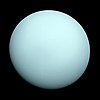 |
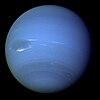 |
 |
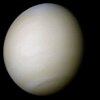
| |
| Sun | Jupiter | Saturn | Uranus | Neptune | Earth | Venus |
 |
 |
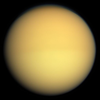 |
 |
 |
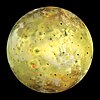 |
 |
| Mars | Ganymede | Titan | Mercury | Callisto | Io | Moon |
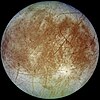 |
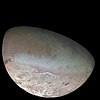 |
 |
 |
 |
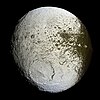 |
 |
| Europa | Triton | Titania | Rhea | Oberon | Iapetus | Umbriel |
 |
 |
 |
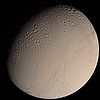 |
 |
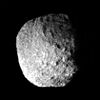 | |
| Ariel | Dione | Tethys | Vesta | Enceladus | Miranda | Proteus |
 |
 |
 |
 |
 |
 |
|
| Mimas | Hyperion | Phoebe | Janus | Amalthea | Epimetheus | Lutetia |
 |
 |
 |
 |
 |
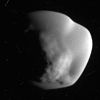 |
 |
| Prometheus | Pandora | Mathilde | Helene | Ida | Atlas | Telesto |
 |
 |
 |
 |
 |
 |
 |
| Phobos | Deimos | Gaspra | Tempel 1 | Borrelly | Wild 2 | Hartley 2 |
Notes
- † Using equatorial radius and assuming body is spherical
- ‡ Using three radii and assuming body is spheroid
- * Radius is known only very approximately
- R Radius has been determined by various methods, such as optical (Hubble), thermal (Spitzer), or direct imaging via spacecraft
- 9 Unknown radius, generic assumed albedo of 0.09
- $ Well studied asteroid or moon where the dimensions and mass are very well known. Asteroid sizes and masses taken from James Baer's (Bio) personal website.
- M Mass has been determined by perturbation. For asteroids, see James Baer's personal website.
- A Assumed mass
- P Mass calculated assuming Pluto's density of 2.0 g/cm3
- Note: For many of the well-determined moons, radii were taken from the JPL Solar System Dynamics page.
- O Radius has been determined with Asteroid occultation
References
- ^ Mike Brown. "The Dwarf Planets". CalTech. Archived from the original on 2011-02-12. Retrieved 2008-09-25.
{{cite web}}: Unknown parameter|deadurl=ignored (|url-status=suggested) (help) - ^ D. T. Britt; G. J. Consol-magno SJ; W. J. Merline (2006). "Small Body Density and Porosity: New Data, New Insights" (PDF). Lunar and Planetary Science XXXVII. Retrieved 2008-12-16.
{{cite web}}: CS1 maint: multiple names: authors list (link) - ^ a b c d e f g h i j k l m n o p q r s t u v w x y z aa ab ac ad ae af ag ah ai aj ak "Planetary Satellite Physical Parameters". JPL (Solar System Dynamics). 2008-10-24. Retrieved 2008-12-16. Cite error: The named reference "jplssd" was defined multiple times with different content (see the help page).
- ^ a b Williams, Dr. David R. (2007-11-23). "Uranian Satellite Fact Sheet". NASA (National Space Science Data Center). Archived from the original on 2010-01-18. Retrieved 2008-12-12.
{{cite web}}: Unknown parameter|deadurl=ignored (|url-status=suggested) (help) - ^ a b c d e f g h i j k l m n o p q r s t u v w x y z aa ab ac ad ae Mike Brown, How many dwarf planets are there in the outer solar system?[1]
- ^ Densities of those KBOs whose masses are uncertain are assumed to be 2.0 in line with Pluto
- ^ Jacobson, R. A. (2006). "The gravity field of the saturnian system from satellite observations and spacecraft tracking data". The Astronomical Journal. 132 (6): 2520–2526. Bibcode:2006AJ....132.2520J. doi:10.1086/508812.
{{cite journal}}: Unknown parameter|coauthors=ignored (|author=suggested) (help); Unknown parameter|month=ignored (help) - ^ "Size, density, albedo and atmosphere limit of dwarf planet Eris from a stellar occultation" (PDF). European Planetary Science Congress Abstracts. 6. 2011. Retrieved 2011-09-14.
- ^ M.E. Brown and E.L. Schaller (2007). "The Mass of Dwarf Planet Eris". Science. 316 (5831): 1585. Bibcode:2007Sci...316.1585B. doi:10.1126/science.1139415. PMID 17569855. Archived from the original on 2011-02-12.
{{cite journal}}: Unknown parameter|deadurl=ignored (|url-status=suggested) (help) - ^ Young, Eliot F.; Young, L. A.; Buie, M. (2007). "Pluto's Radius". American Astronomical Society, DPS meeting #39, #62.05; Bulletin of the American Astronomical Society. 39: 541. Bibcode:2007DPS....39.6205Y.
{{cite journal}}: CS1 maint: multiple names: authors list (link) - ^ Space Daily - SATURN DAILY DLR Researchers Compile Atlas Of Saturn's Moon Rhea, An Icy Alien World (2010)
- ^ Thomas, P. C. (2007). "Shapes of the Cronian icy satellites and their significance". Icarus. 190 (2): 573–584. Bibcode:2007Icar..190..573T. doi:10.1016/j.icarus.2007.03.012.
{{cite journal}}: Cite has empty unknown parameter:|month=(help); Unknown parameter|coauthors=ignored (|author=suggested) (help) [dead link] - ^ a b T.L. Lim, J. Stansberry, T.G. Müller (2010). ""TNOs are Cool": A survey of the trans-Neptunian region III. Thermophysical properties of 90482 Orcus and 136472 Makemake". Astronomy and Astrophysics. 518: L148. Bibcode:2010A&A...518L.148L. doi:10.1051/0004-6361/201014701.
{{cite journal}}: CS1 maint: multiple names: authors list (link) Cite error: The named reference "Lim2010" was defined multiple times with different content (see the help page). - ^ B. Sicardy; et al. (2006). "Charon's size and an upper limit on its atmosphere from a stellar occultation". Nature. 439 (7072): 52. Bibcode:2006Natur.439...52S. doi:10.1038/nature04351. PMID 16397493.
{{cite journal}}: Explicit use of et al. in:|author=(help) - ^
Michael E. Brown. "The largest Kuiper belt objects". In M. Antonietta Barucci, Hermann Boehnhardt, Dale P. Cruikshank (ed.). The Solar System Beyond Neptune (pdf). University of Arizona Press. pp. 335–345. ISBN 0-8165-2755-5.
{{cite book}}: CS1 maint: multiple names: editors list (link) - ^ Michael E. Brown; Burgasser, A.J.; Fraser W.C. (2011). "The Surface Composition of Large Kuiper Belt Object 2007 OR10" (PDF). Mike Brown's Website. arXiv:1108.1418. Retrieved 2011-08-08.
{{cite web}}: CS1 maint: multiple names: authors list (link) - ^
J. Stansberry, W. Grundy, M. Brown; et al. (2008). "Physical Properties of Kuiper Belt and Centaur Objects: Constraints from Spitzer Space Telescope". The Solar System beyond Neptune. University of Arizona Press. arXiv:astro-ph/0702538. Bibcode:2008ssbn.book..161S.
{{cite journal}}: Explicit use of et al. in:|author=(help)CS1 maint: multiple names: authors list (link) - ^ a b Pedro Lacerda and David C. Jewitt - Densities of Solar System Objects from their Rotational Lightcurves (2006)- Institute for Astronomy, University of Hawaii, 2680 Woodlawn Drive, Honolulu, HI 96822
- ^ a b c Brown, Michael E. (2010). "Quaoar: A Rock in the Kuiper belt". The Astrophysical Journal. 714 (2): 1547. arXiv:1003.5911. Bibcode:2010ApJ...714.1547F. doi:10.1088/0004-637X/714/2/1547.
{{cite journal}}: Unknown parameter|coauthors=ignored (|author=suggested) (help) Cite error: The named reference "Brown2010" was defined multiple times with different content (see the help page). - ^ a b c d e f g h i j k l m n o p q r s John Stansberry, Will Grundy, Mike Brown, Dale Cruikshank, John Spencer, David Trilling, Jean-Luc Margot (2007). "Physical Properties of Kuiper Belt and Centaur Objects: Constraints from Spitzer Space Telescope". University of Arizona, Lowell Observatory, California Institute of Technology, NASA Ames Research Center, Southwest Research Institute, Cornell University. arXiv:astro-ph/0702538. Bibcode:2008ssbn.book..161S.
{{cite journal}}: CS1 maint: multiple names: authors list (link) - ^ a b c d e f g h i j k l m n o p q r s t u v w x y z aa ab ac ad ae Wm. Robert Johnston (7 August 2010). "List of Known Trans-Neptunian Objects". Johnston's Archive. Retrieved 2011-03-03.
- ^ a b c d e f g h i j k l m n o p q r s t u v w x y z Wm. Robert Johnston (22 August 2008). "List of Known Trans-Neptunian Objects". Johnston's Archive. Retrieved 2008-12-08. Cite error: The named reference "johnston" was defined multiple times with different content (see the help page).
- ^ Marc W. Buie (2010-06-16 using 19 of 19 observations over 0.98 years (356 days)). "Orbit Fit and Astrometric record for 10KZ39". SwRI (Space Science Department). Retrieved 2011-08-18.
{{cite web}}: Check date values in:|date=(help) - ^ "2010 KZ39". IAU Minor Planet Center. Retrieved 2011-08-18.
- ^ Densities of those KBOs whose masses are uncertain are assumed to be 2.0 in line with Pluto
- ^ a b Wm. Robert Johnston (7 August 2010). "List of Known Trans-Neptunian Objects". Johnston's Archive. Retrieved 2011-04-09.
- ^ Alan Chamberlin. "JPL Small-Body Database Browser". Ssd.jpl.nasa.gov. Archived from the original on 2011-02-12. Retrieved 2011-01-04.
{{cite web}}: Unknown parameter|deadurl=ignored (|url-status=suggested) (help) - ^
Schmidt, B. E.; et al. (2008). "Hubble takes a look at Pallas: Shape, size, and surface" (PDF). 39th Lunar and Planetary Science Conference (Lunar and Planetary Science XXXIX). Held March 10–14, 2008, in League City, Texas. 1391: 2502. Retrieved 2008-08-24.
{{cite journal}}: Explicit use of et al. in:|author=(help) - ^ Baer, James (2008). "Astrometric masses of 21 asteroids, and an integrated asteroid ephemeris" (PDF). Celestial Mechanics and Dynamical Astronomy. 100 (2008). Springer Science+Business Media B.V. 2007: 27–42. Bibcode:2008CeMDA.100...27B. doi:10.1007/s10569-007-9103-8. Retrieved 2008-11-11.
{{cite journal}}: Unknown parameter|coauthors=ignored (|author=suggested) (help) - ^ "Planetary Satellite Physical Parameters". JPL (Solar System Dynamics). 2006-07-13. Archived from the original on 2010-01-18. Retrieved 2008-02-09.
{{cite web}}: Unknown parameter|deadurl=ignored (|url-status=suggested) (help) - ^ Wm. Robert Johnston (26 November 2008). "(119979) 2002 WC19". Johnston's Archive. Retrieved 2009-03-04.
- ^ "JPL definition of Main-belt Asteroid (MBA)". JPL Solar System Dynamics. Retrieved 2009-03-12.
- ^ a b "List of known trans-Neptunian objects". Johnstonsarchive.net. 2010-08-07. Archived from the original on 2007-06-20. Retrieved 2011-01-04.
{{cite web}}: Unknown parameter|deadurl=ignored (|url-status=suggested) (help) - ^ Muller, T.G. (2010). ""TNOs are Cool": A survey of the trans-Neptunian region I. Results from the Herschel science demonstration phase (SDP)". Astronomy and Astrophysics. 518: L146. Bibcode:2010A&A...518L.146M. doi:10.1051/0004-6361/201014683. Archived from the original on 2011-02-12.
{{cite journal}}: Unknown parameter|coauthors=ignored (|author=suggested) (help); Unknown parameter|deadurl=ignored (|url-status=suggested) (help) - ^ a b c d e f g h i j k l m n o p q r s t u v w x y z aa ab ac ad ae af ag ah ai aj ak al am an ao ap aq ar as at au av aw ax ay az ba bb bc bd be bf bg bh bi bj bk bl bm bn bo bp bq br bs bt bu bv bw bx by bz ca cb cc cd ce cf cg ch ci cj ck cl cm cn co cp cq cr cs ct cu cv cw cx cy cz da db dc dd de df dg dh di dj dk dl dm dn do dp dq dr ds dt du dv dw dx dy dz ea eb ec ed ee ef eg eh ei ej ek el em en eo ep eq er es et eu ev ew ex ey ez fa fb fc fd fe ff fg fh fi fj fk fl fm fn fo fp fq fr fs ft fu fv Asteroid Data Archive, Archive Planetary Science Institute
- ^ a b c d e f g M. Kaasalainen (2002). "Models of Twenty Asteroids from Photometric Data" (PDF). Icarus. 159 (2): 369. Bibcode:2002Icar..159..369K. doi:10.1006/icar.2002.6907. Retrieved 2009-06-23.
- ^ Clara Moskowitz (2010-06-16). "Scientists size up a bright mini-world". MSNBC. Retrieved 2010-06-16.
- ^ a b c Benecchi, S.D (2010). "(47171) 1999 TC36, A Transneptunian Triple". Icarus. 207 (2): 978–991. arXiv:0912.2074. Bibcode:2010Icar..207..978B. doi:10.1016/j.icarus.2009.12.017.
{{cite journal}}: Unknown parameter|coauthors=ignored (|author=suggested) (help) - ^ Müller, T. G (2004). "65 Cybele in the thermal infrared: Multiple observations and thermophysical analysis". Astronomy and Astrophysics. 418 (1): 347–356. arXiv:astro-ph/0401458. Bibcode:2004A&A...418..347M. doi:10.1051/0004-6361:20040025.
{{cite journal}}:|access-date=requires|url=(help); Unknown parameter|coauthors=ignored (|author=suggested) (help) - ^ "JPL Small-Body Database Browser: 65 Cybele". 2008-08-10 last obs. Archived from the original on 2010-01-17. Retrieved 2008-11-25.
{{cite web}}: Check date values in:|date=(help); Unknown parameter|deadurl=ignored (|url-status=suggested) (help) - ^ a b J. Torppa; et al. (2003). "Shapes and rotational properties of thirty asteroids from photometric data" (PDF). Icarus. 164 (2): 346. Bibcode:2003Icar..164..346T. doi:10.1016/S0019-1035(03)00146-5.
{{cite journal}}: Unknown parameter|author-separator=ignored (help) - ^ Alan Chamberlin. "JPL Small-Body Database Browser". Ssd.jpl.nasa.gov. Archived from the original on 2011-02-12. Retrieved 2011-01-04.
{{cite web}}: Unknown parameter|deadurl=ignored (|url-status=suggested) (help) - ^ a b "List of Known Trans-Neptunian Objects". Johnston's Archive. Archived from the original on 2007-06-20. Retrieved 2006-12-14.
{{cite web}}: Unknown parameter|deadurl=ignored (|url-status=suggested) (help) - ^ Johnston's Archive about (148780) Altjira
- ^ "JPL Small-Body Database Browser: 88 Thisbe". 2008-07-04 last obs. Retrieved 2008-11-06.
{{cite web}}: Check date values in:|date=(help) - ^ "2002 KW14". Sphinx.planetwaves.net. Archived from the original on 2011-02-12. Retrieved 2011-01-04.
{{cite web}}: Unknown parameter|deadurl=ignored (|url-status=suggested) (help) - ^ Storrs, Alex (1998). "Imaging Observations of Asteroids with Hubble Space Telescope" (PDF). Icarus. 137 (2): 260–268. Bibcode:1999Icar..137..260S. doi:10.1006/icar.1999.6047. Retrieved 2005-01-15.
{{cite journal}}: Unknown parameter|coauthors=ignored (|author=suggested) (help) [dead link] - ^ "JPL Small-Body Database Browser: 48 Doris". 2008-06-13 last obs. Archived from the original on 2010-01-17. Retrieved 2008-11-10.
{{cite web}}: Check date values in:|date=(help); Unknown parameter|deadurl=ignored (|url-status=suggested) (help) - ^ Millis, R.L (1984). "The diameter of 375 URSULA from its occultation of AG + 39 deg 303". Astronomical Journal. 89: 592–596. Bibcode:1984AJ.....89..592M. doi:10.1086/113553.
{{cite journal}}: Unknown parameter|coauthors=ignored (|author=suggested) (help) - ^ Durech., J.; Kaasalainen, M., Marciniak, A.; et al., “Physical models of ten asteroids from an observers' collaboration network”, Astronomy and Astrophysics, Volume 465, Issue 1, April I 2007, pp. 331-337
- ^ Stansberry, Grundy, Brown, Spencer, Trilling, Cruikshank, Luc Margot Physical Properties of Kuiper Belt and Centaur Objects: Constraints from Spitzer Space Telescope (2007) Preprint arXiv
- ^ [Planetary occultations: 2001 results|http://occsec.wellington.net.nz/planet/2001/plnres01.htm#Aurora]
- ^ Fernandes, Yanga R. (2003). "The albedo distribution of Jovian Trojan asteroids". The Astronomical Journal. 126 (3): 1563–1574. Bibcode:2003AJ....126.1563F. doi:10.1086/377015. Archived from the original on 2011-02-12.
{{cite journal}}: Unknown parameter|coauthors=ignored (|author=suggested) (help); Unknown parameter|deadurl=ignored (|url-status=suggested) (help) - ^ "JPL Small-Body Database Browser: 7 Iris". 2009-03-17 last obs. Retrieved 2009-03-17.
{{cite web}}: Check date values in:|date=(help) - ^ Alan Chamberlin. "JPL Small-Body Database Browser". Ssd.jpl.nasa.gov. Archived from the original on 2011-02-12. Retrieved 2011-01-04.
{{cite web}}: Unknown parameter|deadurl=ignored (|url-status=suggested) (help) - ^ Davies, J. K.; Tholen, D. J.; Ballantyne, D. R. (1996). "Infrared Observations of Distant Asteroids". Completing the Inventory of the Solar System, Astronomical Society of the Pacific Conference Proceedings. 107: 97–105. Bibcode:1996ciss.conf...97D.
{{cite journal}}: CS1 maint: multiple names: authors list (link) - ^ a b c Grundy, W.M. (2007). "The orbit, mass, size, albedo, and density of (65489) Ceto/Phorcys: A tidally-evolved binary Centaur". Icarus. 191 (1): 286. arXiv:0704.1523. Bibcode:2007Icar..191..286G. doi:10.1016/j.icarus.2007.04.004.
{{cite journal}}: Unknown parameter|coauthors=ignored (|author=suggested) (help) Cite error: The named reference "Grundy2007" was defined multiple times with different content (see the help page). - ^ Alan Chamberlin. "JPL Small-Body Database Browser". Ssd.jpl.nasa.gov. Archived from the original on 2011-02-12. Retrieved 2011-01-04.
{{cite web}}: Unknown parameter|deadurl=ignored (|url-status=suggested) (help) - ^ a b (Note, he assumed geometric albedo of 0.04-->) Sheppard, S. S., Jewitt, D. C., Porco, C.; Jupiter's Outer Satellites and Trojans, in Jupiter: The Planet, Satellites and Magnetosphere, edited by Fran Bagenal, Timothy E. Dowling, William B. McKinnon, Cambridge Planetary Science, Vol. 1, Cambridge, UK: Cambridge University Press, ISBN 978-0-521-81808-7, 2004, pp. 263-280 [dead link]
- ^ Emelyanov, N.V. (2005). "The mass of Himalia from the perturbations on other satellites". Astronomy and Astrophysics. 438 (3): L33–L36. Bibcode:2005A&A...438L..33E. doi:10.1051/0004-6361:200500143.
{{cite journal}}:|access-date=requires|url=(help); Unknown parameter|coauthors=ignored (|author=suggested) (help) - ^ http://www.cfa.harvard.edu/iau/lists/NumberedMPs.txt Template:WebCite
- ^ Thomas, P.C. (1998). "The Small Inner Satellites of Jupiter". Icarus. 135 (1): 360–371. Bibcode:1998Icar..135..360T. doi:10.1006/icar.1998.5976. Archived from the original on 2011-02-12.
{{cite journal}}: Unknown parameter|coauthors=ignored (|author=suggested) (help); Unknown parameter|deadurl=ignored (|url-status=suggested) (help) - ^ Anderson, J.D. (2005). "Amalthea's Density Is Less Than That of Water". Science. 308 (5726): 1291–1293. Bibcode:2005Sci...308.1291A. doi:10.1126/science.1110422. PMID 15919987. Archived from the original on 2007-06-28.
{{cite journal}}: Unknown parameter|coauthors=ignored (|author=suggested) (help); Unknown parameter|deadurl=ignored (|url-status=suggested) (help) - ^ a b Descamps, P. (2008). "New determination of the size and bulk density of the binary asteroid 22 Kalliope from observations of mutual eclipses". Icarus. 196 (2): 578–600. arXiv:0710.1471. Bibcode:2008Icar..196..578D. doi:10.1016/j.icarus.2008.03.014. Archived from the original on 2011-02-12.
{{cite journal}}: Unknown parameter|coauthors=ignored (|author=suggested) (help); Unknown parameter|deadurl=ignored (|url-status=suggested) (help) - ^ Alan Chamberlin. "JPL Small-Body Database Browser". Ssd.jpl.nasa.gov. Archived from the original on 2011-02-12. Retrieved 2011-01-04.
{{cite web}}: Unknown parameter|deadurl=ignored (|url-status=suggested) (help) - ^ JPL Small-Body Database Browser on 20461 Dioretsa
- ^ Alan Chamberlin. "JPL Small-Body Database Browser". Ssd.jpl.nasa.gov. Archived from the original on 2007-06-23. Retrieved 2011-01-04.
{{cite web}}: Unknown parameter|deadurl=ignored (|url-status=suggested) (help) - ^ "JPL Small-Body Database Browser: 14 Irene". 2008-04-14 last obs. Retrieved 2008-11-27.
{{cite web}}: Check date values in:|date=(help) - ^ "Dwarf planet Eris bigger than Pluto - Astronomy Magazine". Astronomy.com. 2007-06-14. Archived from the original on 2011-02-12. Retrieved 2011-01-04.
{{cite web}}: Unknown parameter|deadurl=ignored (|url-status=suggested) (help) - ^ Alan Chamberlin. "JPL Small-Body Database Browser". Ssd.jpl.nasa.gov. Archived from the original on 2011-02-12. Retrieved 2011-01-04.
{{cite web}}: Unknown parameter|deadurl=ignored (|url-status=suggested) (help) - ^ JPL 508 Template:WebCite
- ^ Johnston's Archive about (66652) Borasisi and Pabu
- ^ "(212) Médée." Wikipédia, l'encyclopédie libre. 16 jan 2009, 21:16 UTC. 13 mar 2009, 00:01 <http://fr.wikipedia.org/w/index.php?title=(212)_M%C3%A9d%C3%A9e&oldid=37119259>.
- ^ "JPL Small-Body Database Browser: 92 Undina". Archived from the original on 2010-01-17. Retrieved 2010-10-09.
{{cite web}}: Unknown parameter|deadurl=ignored (|url-status=suggested) (help) - ^ Michalak, G. (2001). "Determination of asteroid masses". Astronomy & Astrophysics. 374 (2): 703–711. Bibcode:2001A&A...374..703M. doi:10.1051/0004-6361:20010731. Retrieved 2008-11-10.
- ^ Bange, J.F (1997). "DETERMINATION OF THE MASSES OF MINOR PLANETS" (PDF): 169. Retrieved 2008-11-10.
{{cite journal}}: Cite journal requires|journal=(help); Unknown parameter|coauthors=ignored (|author=suggested) (help) - ^ Alan Chamberlin. "JPL Small-Body Database Browser". Ssd.jpl.nasa.gov. Archived from the original on 2011-02-12. Retrieved 2011-01-04.
{{cite web}}: Unknown parameter|deadurl=ignored (|url-status=suggested) (help) - ^ Spitale, J. N.; et al. (2006). "The orbits of Saturn's small satellites derived from combined historic and Cassini imaging observations". The Astronomical Journal. 132 (2): 692–710. Bibcode:2006AJ....132..692S. doi:10.1086/505206. Archived from the original on 2011-02-12.
{{cite journal}}: Explicit use of et al. in:|author=(help); Unknown parameter|deadurl=ignored (|url-status=suggested) (help) - ^ Alan Chamberlin. "JPL Small-Body Database Browser". Ssd.jpl.nasa.gov. Archived from the original on 2011-02-12. Retrieved 2011-01-04.
{{cite web}}: Unknown parameter|deadurl=ignored (|url-status=suggested) (help) - ^ Jonathan Amos - Asteroid Lutetia has thick blanket of debris (4 October 2010) - BBC News Template:WebCite
- ^ average of values taken from:
H. A. Weaver (2006). "Discovery of two new satellites of Pluto". Nature. 439 (7079): 943–945. arXiv:astro-ph/0601018. Bibcode:2006Natur.439..943W. doi:10.1038/nature04547. PMID 16495991.
{{cite journal}}: Unknown parameter|coauthors=ignored (|author=suggested) (help); Unknown parameter|month=ignored (help) - ^ "IRAS Minor Planet Survey". Archived from the original on 2005-12-11.
- ^ a b "(90) Antiope and S/2000 (90) 1". Johnstonsarchive.net. Archived from the original on 2011-02-12. Retrieved 2011-01-04.
{{cite web}}: Unknown parameter|deadurl=ignored (|url-status=suggested) (help) - ^ a b c Planetary Satellite Physical Parameters - NASA - 2011
- ^ "JPL Small-Body Database Browser: 60558 Echeclus (2000 EC98)". 2008-05-07 last obs. Retrieved 2008-09-09.
{{cite web}}: Check date values in:|date=(help) - ^ Tedesco; et al. (2004). "Supplemental IRAS Minor Planet Survey (SIMPS)". IRAS-A-FPA-3-RDR-IMPS-V6.0. Planetary Data System. Archived from the original on 2010-01-17. Retrieved December 31, 2008.
{{cite web}}: Explicit use of et al. in:|author=(help); Unknown parameter|deadurl=ignored (|url-status=suggested) (help) - ^ "JPL Small-Body Database Browser: 84 Klio". 2008-03-30 last obs. Retrieved 2008-11-06.
{{cite web}}: Check date values in:|date=(help) - ^ Grundy, W. M (2005). "Diverse albedos of small trans-neptunian objects". Icarus. 176 (1): 184–191. arXiv:astro-ph/0502229. Bibcode:2005Icar..176..184G. doi:10.1016/j.icarus.2005.01.007.
{{cite journal}}:|access-date=requires|url=(help); Unknown parameter|coauthors=ignored (|author=suggested) (help) (Preprint on arXiv.) - ^ Barucci, M. A., de Bergh, C., Cuby, J.-G., Le Bras, A., Schmitt, B., & Romon, J. (2000). "Infrared spectroscopy of the Centaur 8405 Asbolus: first observations at ESO-VLT". Astronomy and Astrophysics. 357: L53–L56. Bibcode:2000A&A...357L..53B. Archived from the original on 2011-02-12.
{{cite journal}}: Unknown parameter|deadurl=ignored (|url-status=suggested) (help)CS1 maint: multiple names: authors list (link) - ^ Alan Chamberlin. "JPL Small-Body Database Browser". Ssd.jpl.nasa.gov. Archived from the original on 2011-02-12. Retrieved 2011-01-04.
{{cite web}}: Unknown parameter|deadurl=ignored (|url-status=suggested) (help) - ^ Near-infrared spectra of centaurs and Kuiper belt objects
- ^ "JPL Small-Body Database Browser: C/1995 O1 (Hale-Bopp)". 2007-10-22 last obs. Retrieved 2008-12-05.
{{cite web}}: Check date values in:|date=(help) - ^ Lionel Wilson and Klaus Keil (1991). "Explosive Eruptions on Asteroids: The Missing Basalts on the Aubrite Parent Body". Abstracts of the Lunar and Planetary Science Conference. 22: 1515. Bibcode:1991LPI....22.1515W.
- ^ "2008-07-16 Tracking News". Hohmanntransfer.com. Archived from the original on 2011-02-12. Retrieved 2011-01-04.
{{cite web}}: Unknown parameter|deadurl=ignored (|url-status=suggested) (help) - ^ Pierre Vingerhoets and Jan Van Gestel (2004-01-31). "E.A.O.N. : (4348) Poulydamas". European Asteroidal Occultation Network (E.A.O.N.). Archived from the original on 2011-02-12. Retrieved 2010-05-31.
{{cite web}}: Unknown parameter|deadurl=ignored (|url-status=suggested) (help) - ^ Thomas, P.C. (1998). "The Small Inner Satellites of Jupiter". ICARUS. 135 (1): 360–371. Bibcode:1998Icar..135..360T. doi:10.1006/icar.1998.5976. Archived from the original on 2011-02-12.
{{cite journal}}: Unknown parameter|coauthors=ignored (|author=suggested) (help); Unknown parameter|deadurl=ignored (|url-status=suggested) (help) - ^ Britt et al. 2002, p. 486
- ^ Attention: This template ({{cite doi}}) is deprecated. To cite the publication identified by doi:10.1006/icar.2001.6597, please use {{cite journal}} (if it was published in a bona fide academic journal, otherwise {{cite report}} with
|doi=10.1006/icar.2001.6597instead. - ^ a b c Porco, C. C.; et al. (2007). "Saturn's Small Inner Satellites: Clues to Their Origins". Science. 318 (5856): 1602–1607. Bibcode:2007Sci...318.1602P. doi:10.1126/science.1143977. PMID 18063794. Archived from the original on 2011-02-12.
{{cite journal}}: Explicit use of et al. in:|author=(help); Unknown parameter|deadurl=ignored (|url-status=suggested) (help) - ^ F. Marchis; et al. (2003). "A three-dimensional solution for the orbit of the asteroidal satellite of 22 Kalliope". Icarus. 165 (1): 112. Bibcode:2003Icar..165..112M. doi:10.1016/S0019-1035(03)00195-7. Archived from the original on 2011-02-12.
{{cite journal}}: Explicit use of et al. in:|author=(help); Unknown parameter|deadurl=ignored (|url-status=suggested) (help) - ^ Porco, C.C.; et al. (2006). "Physical Characteristics and Possible Accretionary Origins for Saturn's Small Satellites". Bulletin of the American Astronomical Society. 37: 768. Archived from the original (PDF) on 2007-07-27.
{{cite journal}}: Explicit use of et al. in:|author=(help); Unknown parameter|deadurl=ignored (|url-status=suggested) (help) - ^ IOTA/IOTA-ES occultation update for (2000) Herschel
- ^ JPL Small-Body Database Browser: 2000 Herschel
- ^ "JPL Small-Body Database Browser: 65407 (2002 RP120)". Archived from the original on 2011-02-12. Retrieved 2008-02-06.
{{cite web}}: Unknown parameter|deadurl=ignored (|url-status=suggested) (help) - ^ "The Shape of Gaspra : Galileo's observations of 951 Gaspra". Cat.inist.fr. Archived from the original on 2011-02-12. Retrieved 2011-01-04.
{{cite web}}: Unknown parameter|deadurl=ignored (|url-status=suggested) (help) - ^ a b F. Marchis; et al. (2006). "Shape, size and multiplicity of main-belt asteroids I. Keck Adaptive Optics survey". Icarus. 185 (1): 39. Bibcode:2006Icar..185...39M. doi:10.1016/j.icarus.2006.06.001. PMC 2600456. PMID 19081813. Archived from the original on 2011-02-12.
{{cite journal}}: Explicit use of et al. in:|author=(help); Unknown parameter|deadurl=ignored (|url-status=suggested) (help) - ^ 11 km average diameter 2004 study 1P at the JPL Small-Body Database
- ^ Using the volume of an ellipsoid of 15x8x8km * an assumed rubble pile density of 0.6 g/cm3 yields a mass (m=d*v) of ~3.02E+14 kg
- ^ Scott S. Sheppard. "Uranus' Known Satellites". Carnegie Institution (Department of Terrestrial Magnetism). Retrieved 2011-01-22.
- ^ Porco, C. C.; et al. (2007). "Saturn's Small Inner Satellites: Clues to Their Origins". Science. 318 (5856): 1602–1607. Bibcode:2007Sci...318.1602P. doi:10.1126/science.1143977. PMID 18063794. Archived from the original on 2011-02-12.
{{cite journal}}: Explicit use of et al. in:|author=(help); Unknown parameter|deadurl=ignored (|url-status=suggested) (help) - ^ "Comet 9P/Tempel 1". The Planetary Society. Archived from the original on 2011-02-12. Retrieved 2008-12-16.
{{cite web}}: Unknown parameter|deadurl=ignored (|url-status=suggested) (help) - ^ "JPL Small-Body Database Browser: 9P/Tempel 1". 2008-10-25 last obs. Archived from the original on 2011-02-12. Retrieved 2008-12-16.
{{cite web}}: Check date values in:|date=(help); Unknown parameter|deadurl=ignored (|url-status=suggested) (help) - ^ Cassini Equinox Mission: Thrym (accessed October 2010) Template:WebCite
- ^ Alan Chamberlin. "JPL Small-Body Database Browser". Ssd.jpl.nasa.gov. Archived from the original on 2011-02-12. Retrieved 2011-01-04.
{{cite web}}: Unknown parameter|deadurl=ignored (|url-status=suggested) (help) - ^ "Jupiter, in Astronomy"; The Columbia Encyclopedia, Sixth Edition, 2004. 52323 pgs.
- ^ H. U. Keller, et all - E-Type Asteroid (2867) Steins as Imaged by OSIRIS on Board Rosetta - Science 8 January 2010: Vol. 327. no. 5962, pp. 190 - 193 DOI: 10.1126/science.1179559 [dead link]
- ^ 4.8 km diameter 19P/Borrelly at the JPL Small-Body Database
- ^ 2P/Encke at the JPL Small-Body Database
- ^ C/1996 B2 at the JPL Small-Body Database
- ^ "Comet Hyakutake Home Page (JPL)". .jpl.nasa.gov. Archived from the original on 2011-02-12. Retrieved 2011-01-04.
{{cite web}}: Unknown parameter|deadurl=ignored (|url-status=suggested) (help) - ^ Alan Chamberlin. "JPL Small-Body Database Browser". Ssd.jpl.nasa.gov. Archived from the original on 2011-02-12. Retrieved 2011-01-04.
{{cite web}}: Unknown parameter|deadurl=ignored (|url-status=suggested) (help) - ^ Source: Porco et al. 2005 Template:WebCite
- ^ "Cloudbait Observatory Gallery - Comet Holmes". Cloudbait.com. Archived from the original on 2011-02-12. Retrieved 2011-01-04.
{{cite web}}: Unknown parameter|deadurl=ignored (|url-status=suggested) (help) - ^ Alan Chamberlin. "JPL Small-Body Database Browser". Ssd.jpl.nasa.gov. Archived from the original on 2011-02-12. Retrieved 2011-01-04.
{{cite web}}: Unknown parameter|deadurl=ignored (|url-status=suggested) (help) - ^ 6178 (1986 DA) at the JPL Small-Body Database
- ^ a b Roman Numerals
- ^
Tedesco, Edward (April 4, 2002). "New study reveals twice as many asteroids as previously believed" (Press release). European Space Agency. Retrieved 2009-10-20.
{{cite press release}}: Unknown parameter|coauthors=ignored (|author=suggested) (help) - ^ Minor Planet No. 100,000 Named for Space Age 50th Anniversary (2007) - Space Ref, Quote: "..about a mile in size"
- ^ [JPL Small-Body Database Browser: 100000 Astronautica]
- ^ Alan Chamberlin. "JPL Small-Body Database Browser". Ssd.jpl.nasa.gov. Archived from the original on 2011-02-12. Retrieved 2011-01-04.
{{cite web}}: Unknown parameter|deadurl=ignored (|url-status=suggested) (help) - ^ "(4769) Castalia." Wikipédia, l'encyclopédie libre. 20 jan 2010, 16:37 UTC. 11 oct 2010, 16:48 <http://fr.wikipedia.org/w/index.php?title=(4769)_Castalia&oldid=49048108>
- ^ 3000 x 10^9 kg
- ^ a b Lisse, C. M. (2009). "Spitzer Space Telescope Observations of the Nucleus of Comet 103P/Hartley 2". Publications of the Astronomical Society of the Pacific. 121: 968–975. Bibcode:2009PASP..121..968L. doi:10.1086/605546.
{{cite journal}}: Cite has empty unknown parameter:|1=(help); Unknown parameter|coauthors=ignored (|author=suggested) (help) - ^ "JPL Small-Body Database Browser: 14827 Hypnos (1986 JK)". Archived from the original on 2011-02-12. Retrieved 2008-02-08.
{{cite web}}: Unknown parameter|deadurl=ignored (|url-status=suggested) (help) - ^ Whitman, Kathryn (2006). "The Size-Frequency Distribution of Dormant Jupiter Family Comets". arXiv:astro-ph/0603106. Bibcode:2006Icar..183..101W. doi:10.1016/j.icarus.2006.02.016.
{{cite journal}}: Cite journal requires|journal=(help); Unknown parameter|coauthors=ignored (|author=suggested) (help) - ^ 2062 Aten (this version) [dead link]
- ^ Alan Chamberlin. "JPL Small-Body Database Browser". Ssd.jpl.nasa.gov. Archived from the original on 2011-02-12. Retrieved 2011-01-04.
{{cite web}}: Unknown parameter|deadurl=ignored (|url-status=suggested) (help) - ^ a b c Based on an assumed density of 2.6 g/cm3 as given at the NASA NEO impact risk page http://neo.jpl.nasa.gov/risk/index.html Template:WebCite
- ^ Alan Chamberlin. "JPL Small-Body Database Browser". Ssd.jpl.nasa.gov. Archived from the original on 2011-02-12. Retrieved 2011-01-04.
{{cite web}}: Unknown parameter|deadurl=ignored (|url-status=suggested) (help) - ^ BBC - Giant asteroid passes near Earth - 9 November 2011
- ^ The Herschel Space Observatory catches a glimpse of the minor planet during its rendezvous with Earth (November 17, 2011)
- ^ JPL Small-Body Database Browser (2005 YU55)
- ^ "NASA Scientists Get First Images of Earth Flyby Asteroid". NASA/JPL. 2008-01-25. Archived from the original on 2011-02-12. Retrieved 2008-01-26.
{{cite web}}: Unknown parameter|deadurl=ignored (|url-status=suggested) (help) - ^ [http://neo.jpl.nasa.gov/risk/1994wr12.html NASA - 1994 WR12 Earth Impact Risk Summary - 2011]
- ^ a b c BBC News - Record spin for newfound asteroid (2008) Template:WebCite
- ^ Alan Chamberlin. "JPL Small-Body Database Browser". Ssd.jpl.nasa.gov. Archived from the original on 2011-02-12. Retrieved 2011-01-04.
{{cite web}}: Unknown parameter|deadurl=ignored (|url-status=suggested) (help)
Further reading
- NASA Planetary Data System (PDS)
- Asteroids with Satellites
- Minor Planet discovery circumstances
- Supplemental IRAS Minor Planet Survey (SIMPS) and IRAS Minor Planet Survey (IMPS)
- SIMPS & IMPS (V6, additional, from here)
- Asteroid Data Archive (dead link) Archive Planetary Science Institute
External links
- Planetary fact sheets
- Asteroid fact sheet
- All (known) Bodies in the Solar System Larger than 200 Miles in Diameter - in an image, put side-by-side.
- Size comparison of asteroids and comets visited by space probe (Parent article of image at The Planetary Society)
- Scaled Solar System montage at TPS Blog

